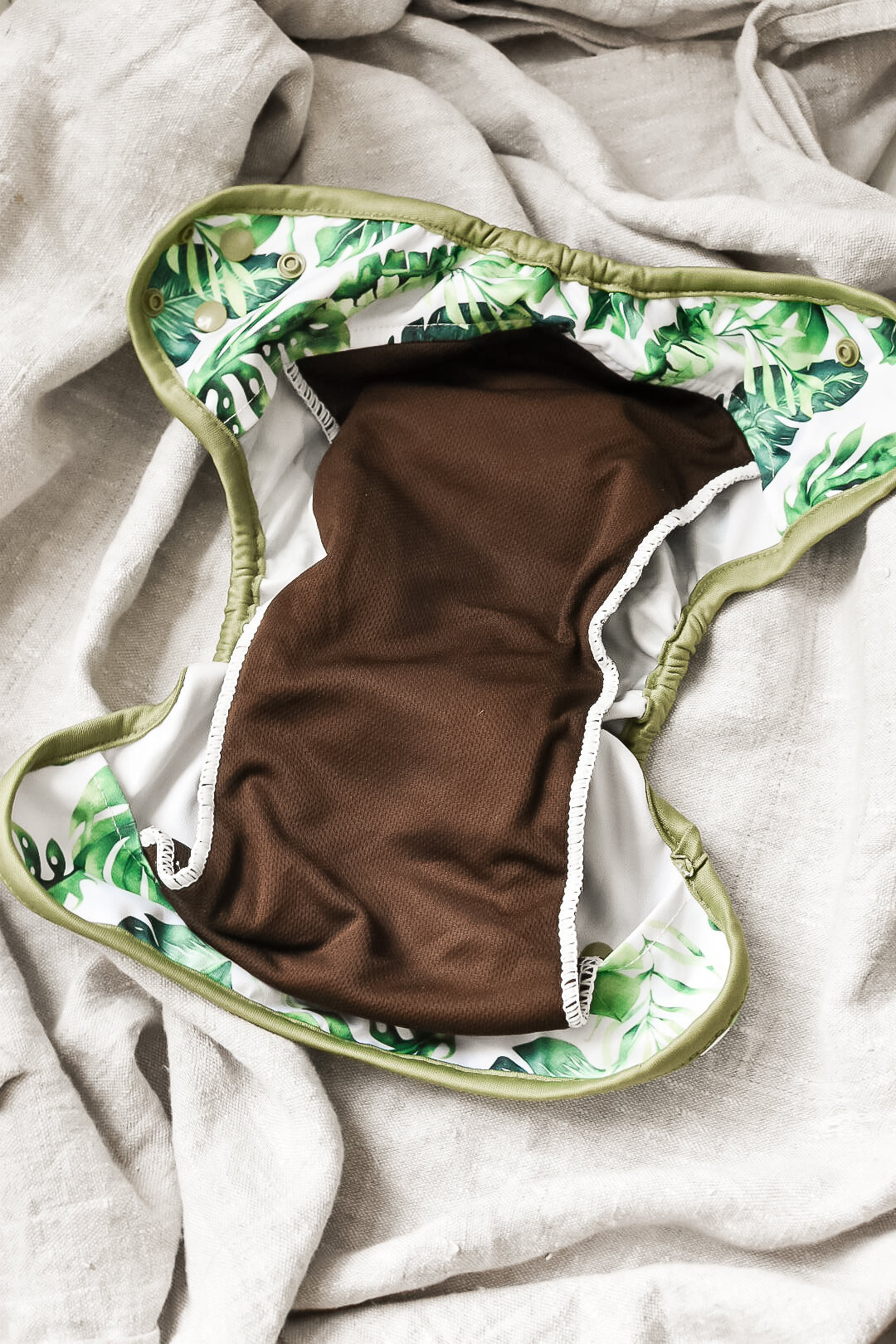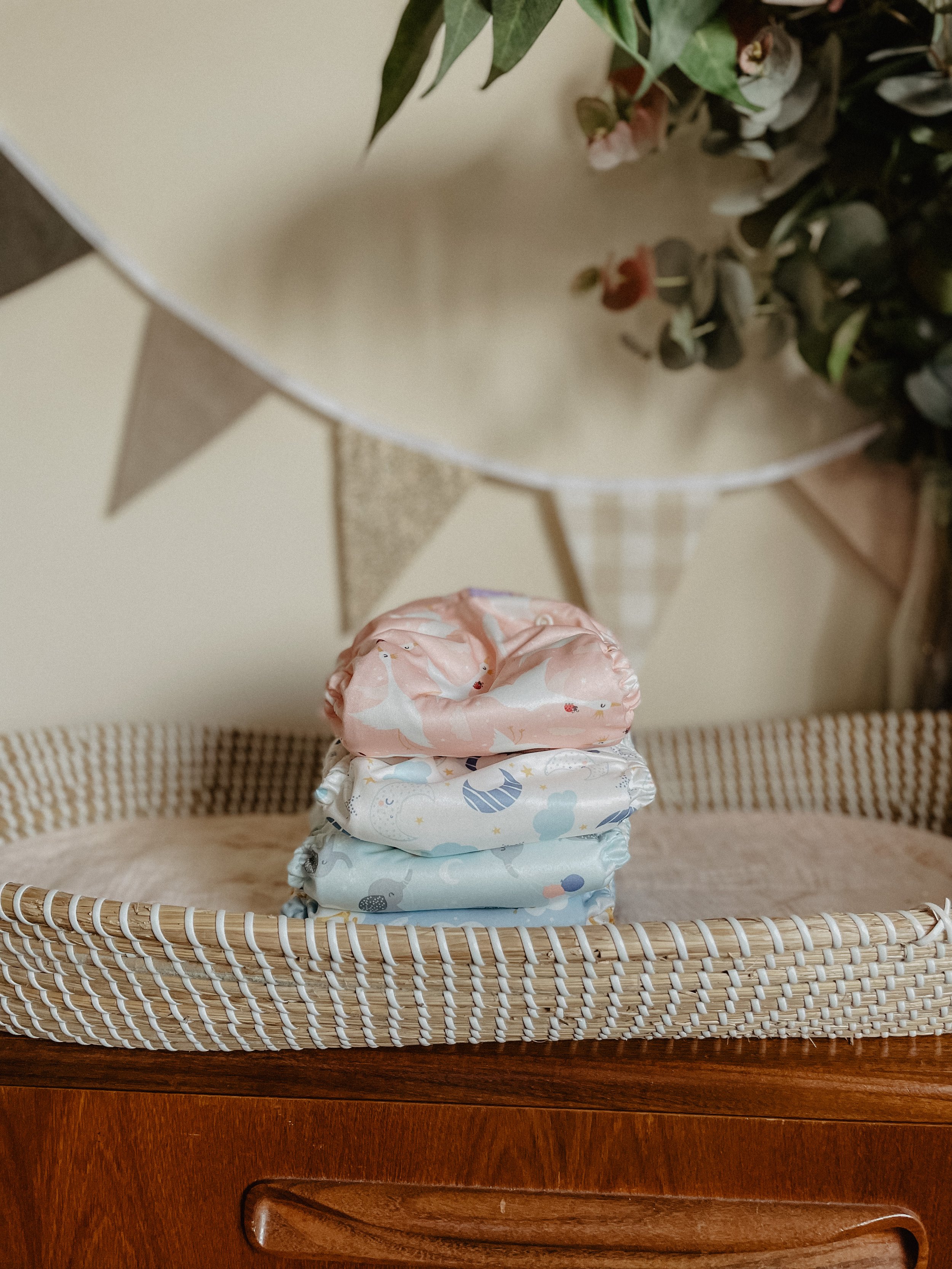The Complete Guide to Types of Cloth Nappy
All-in-one. Snap-in-one. All-in-two. Pocket. Popper and pocket. All-in-one with pocket. Confused? You’re not alone! When it comes to types of cloth nappy, there are about as many different terms as there are nappies out there. And it can all seem very overwhelming!
Today I’d love to help demystify the world of cloth by explaining exactly what all the different kinds of nappy are. Before we dive in, let me just say that ultimately it doesn’t particularly matter how you classify cloth nappies. Different people do it different ways, and brands often have their own terms for things. The aim today is to help you decide which kind(s) of nappy you’d like to try, rather than to perfectly categorise every nappy out there. So, if you’re feeling puzzled by the difference between an all-in-one and all-in-two, you’re in the right place.
But before we get into the detail, here’s a question you might be asking …
How do I tell which type of nappy is right for me?
No matter how much you read on cloth nappies, you will only work out what’s right for you by trying nappies out! This post has a lot of information to help you figure out some of the differences between nappies, but my advice is still to try out as many nappies as you can before committing to investing in a huge stash. People are often surprised at which nappies they end up liking.
Generally I suggest trying one or two of each nappy type. If you’re not sure which nappies to start with, head over to this questionnaire, and I will get back to you with some personalised recommendations based on your circumstances.
Another option is to pick up some nappies to trial, either from a nappy library or from a retailer (like Real Nappy Life).
Ok, let’s talk about the different types of nappy!
The only thing you need to know
It comes down to this. All cloth nappies are made up of a waterproof bit and an absorbent bit. Sometimes they might also have a liner, which is not absorbent and acts as a barrier between the nappy and baby, to catch solids, reduce staining, and possibly also keep baby’s bottom dry. But for now, we’re just going to talk about the waterproof and absorbent bits.
What makes the nappy types different is how the waterproof bit and the absorbent bit are attached (or not). Here’s an overview.
All-in-one nappy: The waterproof bit and the absorbent bit are permanently attached.
All-in-two nappy: The waterproof bit (the cover) and the absorbent bit (the insert) attach and detach, usually with snaps, or are separate but designed to be used together.
Pocket nappy: The waterproof bit (the pocket) and the absorbent bit (the insert) are separate and the absorbent bit sits inside the pocket on the waterproof bit.
Fitted nappy: The waterproof bit is completely separate from the absorbent bit, and the absorbent bit is shaped like a nappy.
Flat nappy: The waterproof bit is completely separate from the absorbent bit, and the absorbent bit is flat.
Let’s look at each type in more detail...
All-in-One Nappies
All-in-one nappies have a waterproof bit and an absorbent bit that are permanently attached. In other words, all the bits of the nappy are in one piece.
There are some variations in the design of the absorbent bits. Some are completely sewn in, others have tongues and some have a pocket to tuck a tongue into (not to be confused with a pocket nappy where the absorbency is separate and tucks into a pocket).
Key features of all-in-ones
Very ease to use, though for some brands you need to stuff the tongue into a pocket
Great for childcare because they look a lot like a disposable
Can be slim fitting, but it varies depending on the nappy
Often slower to dry as the absorbency can’t be detached from the waterproof part.
Generally more expensive than pocket or all-in-two nappies
Usually have to be heavily boosted if used at night
examples of all-in-ones
Here are some examples of all-in-one nappies:
The Thirsties Natural All-in-One has two tongues that lay in the nappy.
The Blueberry Simplex has a tongue that can be laid on top or stuffed into a pocket in the nappy.
The Bambino Mio Mio Solo has a tongue that must be stuffed into a pocket in the nappy.
The Little Lovebum Quick Dry has an insert that is sewn in at either end.
All-in-Two Nappies
All-in-two nappies have a waterproof bit (the cover) and an absorbent bit (the insert) that attach and detach, usually with snaps, or are separate but designed to go together.
The majority of all-in-twos have covers which are entirely waterproof and wipe clean which means that the cover can be reused three or four times before washing, by simply replacing the insert with a fresh one. However some all-in-twos don't have wipe clean covers, and the whole nappy must be replaced at every change.
Most all-in-twos have some method of joining the inserts to the cover, usually with snaps, but sometimes with snaps at either end of the cover. Very occasionally, they don’t attach at all and you simply lay the inserts in the cover. This makes them quite similar to some flat nappies, particularly prefolds, and means that you can often use the covers with flat or fitted nappies inside, instead of the insert provided.
Key features of all-in-twos
Very ease to use, though there’s the tiny step of putting the inserts in the covers
Can sometimes be used for night with the right inserts
Can be good for childcare, though some may be put off by having to replace the inserts. You could send one insert per nappy so that they don’t need to do anything with the inserts.
Often quicker drying than all-in-ones as the absorbency can be detached from the waterproof part.
Affordable, as you can buy just a few covers and more inserts (as long as the cover is wipe clean)
Can be slim fitting, but it varies depending on the nappy inserts.
The covers can sometimes be used with other types of nappy like fitted nappies and flat nappies.
Examples of all-in-twos
Here are some examples of all-in-two nappies:
The Close Parent Pop-In has two snap-in absorbent inserts. The cover is not wipe clean, due to a section of fleece down the middle.
The Bare & Boho One Size has one snap-in insert that snaps in at each end and an additional booster (not pictured). The cover is wipe clean.
The Thirsties Duo wrap is a lay-in style, where the insert is simply placed on top of the wrap.
The Fiyyah Econo wrap is a lay-in style, and also has flaps at either end to hold the inserts in place.
Pocket Nappies
Pocket nappies have a waterproof bit (the pocket) and an absorbent bit (the insert) that are separate, and the absorbent bit sits inside a pocket on the waterproof bit. Pockets usually come with one or two inserts, some of which are folded before stuffing into the pocket. The pocket usually has a layer of fabric such as microfleece on it, so the whole nappy must be changed once wet (rather than simply replacing the insert).
Key features of pocket nappies
Very ease to use, though there’s a little more work than an all-in-one as you need to remove the absorbent insert before washing, and put it back in when clean.
Quicker drying than all-in-ones, because the absorbent insert is removed for washing and drying.
Generally pretty affordable - some are very cheap, while others are slightly more expensive
Great for childcare because they look a lot like a disposable
Can be a little bulky, but it depends a lot on the inserts.
examples of pocket nappies
Here are some examples of pocket nappies:
The Mama Koala pocket nappy comes with two bamboo inserts.
The Little Lamb One Size pocket comes with two bamboo inserts.
The Alva pocket nappy comes with a single microfibre insert.
The Seedling Multi-Fit nappy comes with a bamboo insert that folds into three before stuffing.
Fitted Nappies
Fitted nappies are entirely made up of absorbent material, and you have to add a separate waterproof cover over the top. This means you have two layers to put on at each change, though the waterproof cover can be reused three or four times if it’s not dirty.
key features of fitted nappies
Easy to use, though you have two parts to fit
Slow drying
Generally pretty affordable, though some are more expensive, and you have to factor in the additional cost of wraps
Bulky
Often sized, so you might need to buy multiple sizes before potty training
Great for nighttime - these are the most popular and reliable option for nights
Tend not to be great for childcare due to the work of putting on two layers, but it’s always worth asking!
Examples
Here are some examples of fitted nappies:
The Thirsties Fitted Nappy has a snap-in double booster.
The Little Lamb Fitted nappy comes in a few different options - microfibre (pictured), bamboo and cotton.
The Motherease Sandy’s Fitted nappy comes in a few different options - organic cotton, cotton and bamboo (pictured).
The Tots Bots Bamboozle has a snap-in booster.
Flat Nappies
Flat nappies are flat pieces of absorbent material that are folded and fastened with a nappy fastener or safety pins. They require a waterproof cover over the top. There are three main kinds - terries, muslins and prefolds. You can find out more about flat nappies in my guide to using prefolds and muslins.
Prefolds are a little different to terries in muslins and terries in that they don’t necessarily have to be fastened with a nappy fastener. It’s possible to just fold a prefold into three and place it inside a cover, making them a little like all-in-twos in practice.
Key features of flat nappies
Pretty easy to use once you’ve got used to them, but there is a learning curve as you figure out how to fold them
Very quick drying
Very affordable - the cheapest reusable option
Tend to be pretty bulky, especially terries
Can be used for night, though they may need boosting
Generally not good for childcare, unless you have a carer that’s used them before or is willing to learn
Examples of flat nappies
Here are some examples of flat nappies:
A cotton prefold with nappy fastener.
A bamboo terry with nappy fastener.
Two cotton muslins with nappy fastener.
… One Final Thing
Whilst the vast majority of nappies fit into one of these categories, occasionally a nappy will have elements of more than one type. For example, a few brands have ‘popper and pocket’ style nappies, where the nappy has both snap-in inserts and a pocket. This basically means you can use it either as an all-in-two or as a pocket, or both! Some examples of that style include the Petite Crown Trima, Peachi Baby nappy and Little Lovebum Popper and Pocket. When these are done well, they can be very versatile, though sometimes they end up being the worst of both worlds! As with any nappy, the key is to try them out and see if they work for you!
Some of the nappies pictured were gifted to me. This page contains affiliate links, which earns me a little bit of commission if you make a purchase, at no additional cost to you. Thank you!































